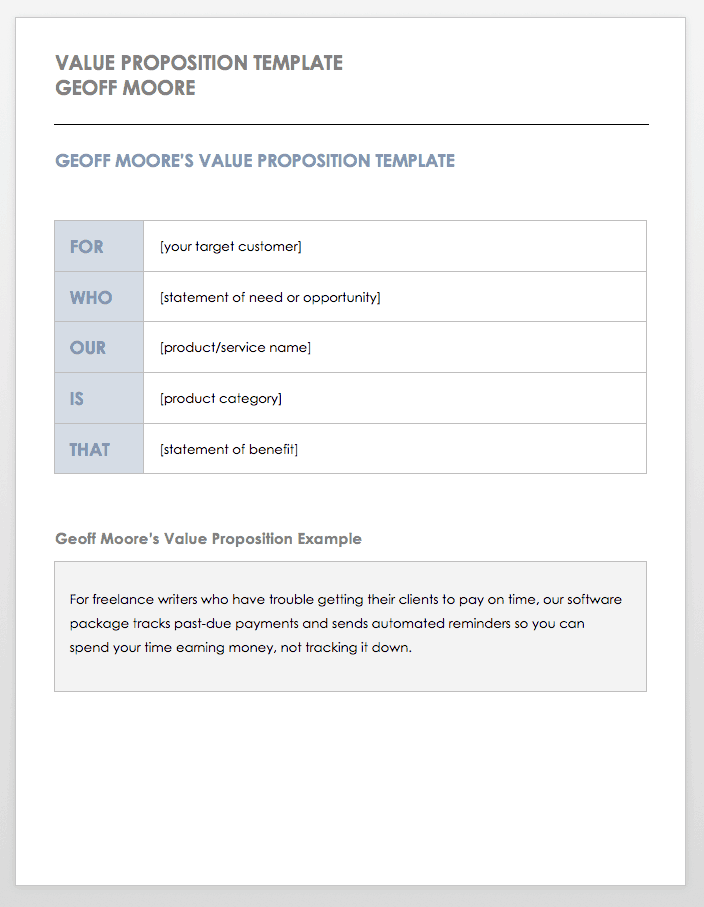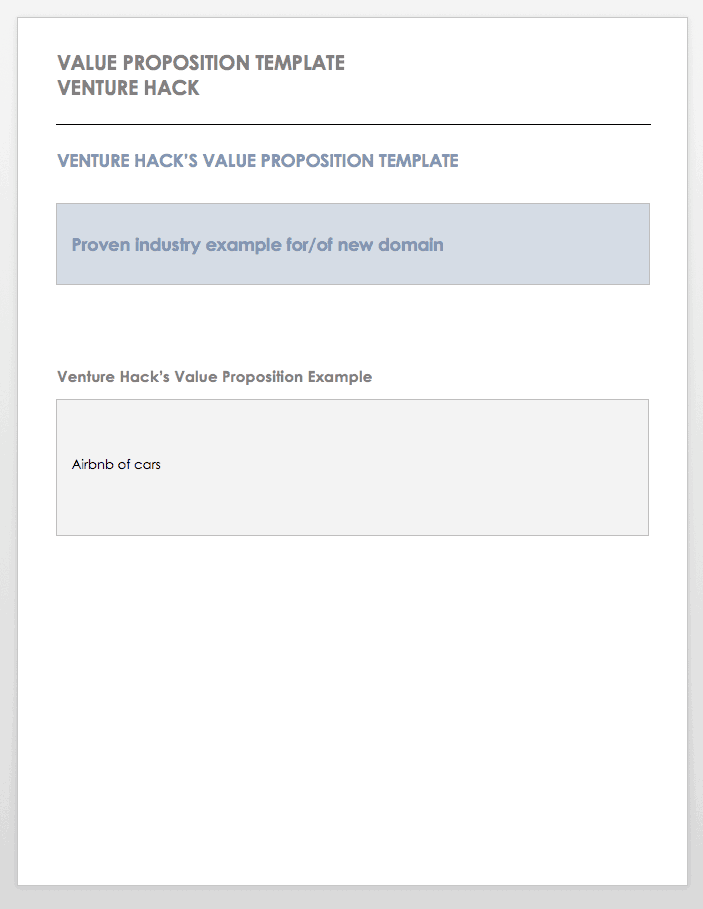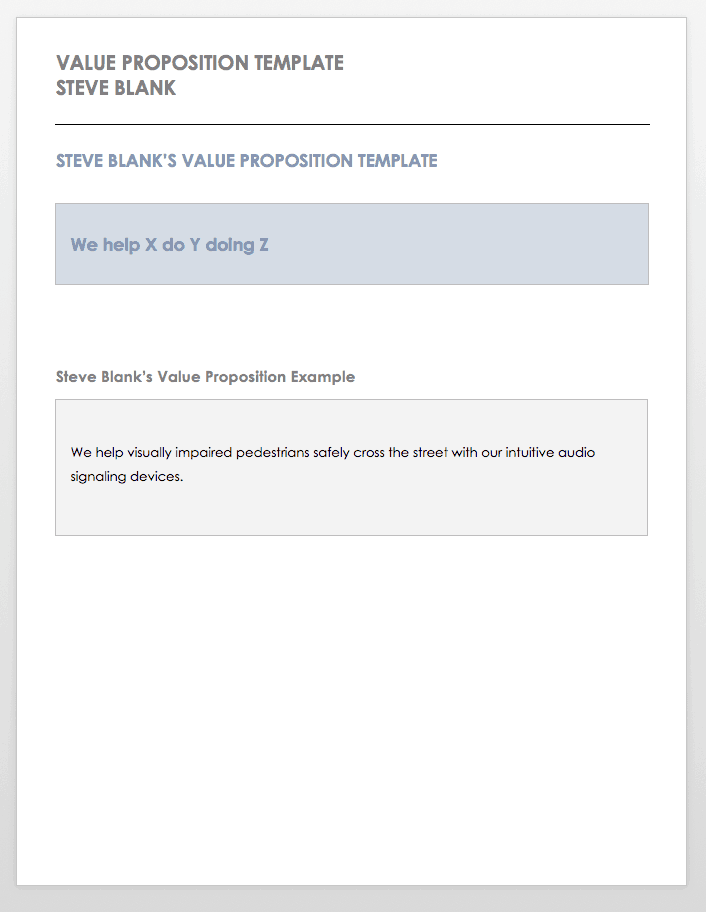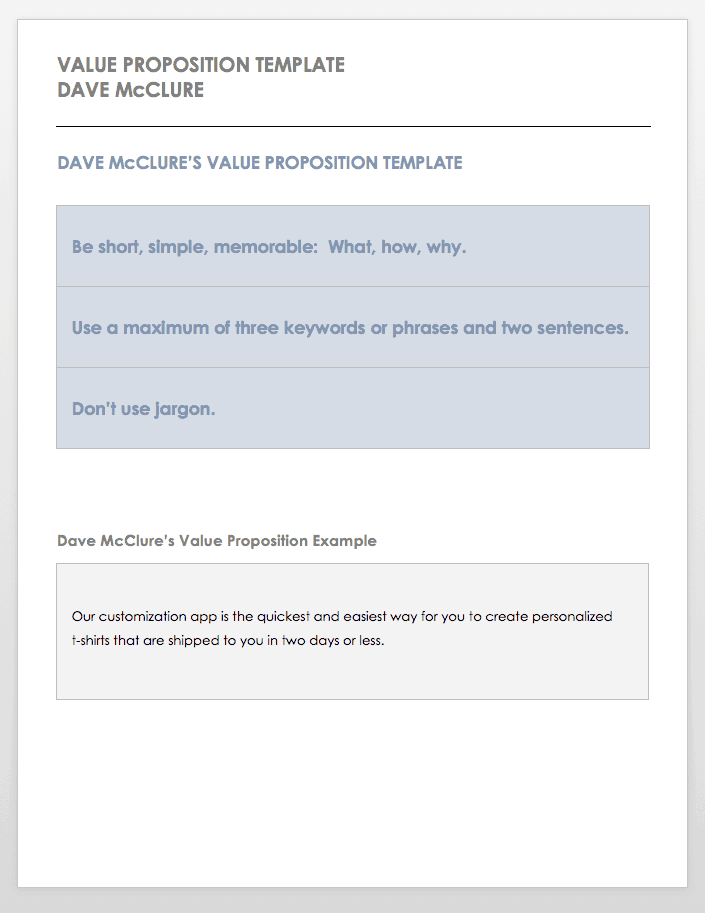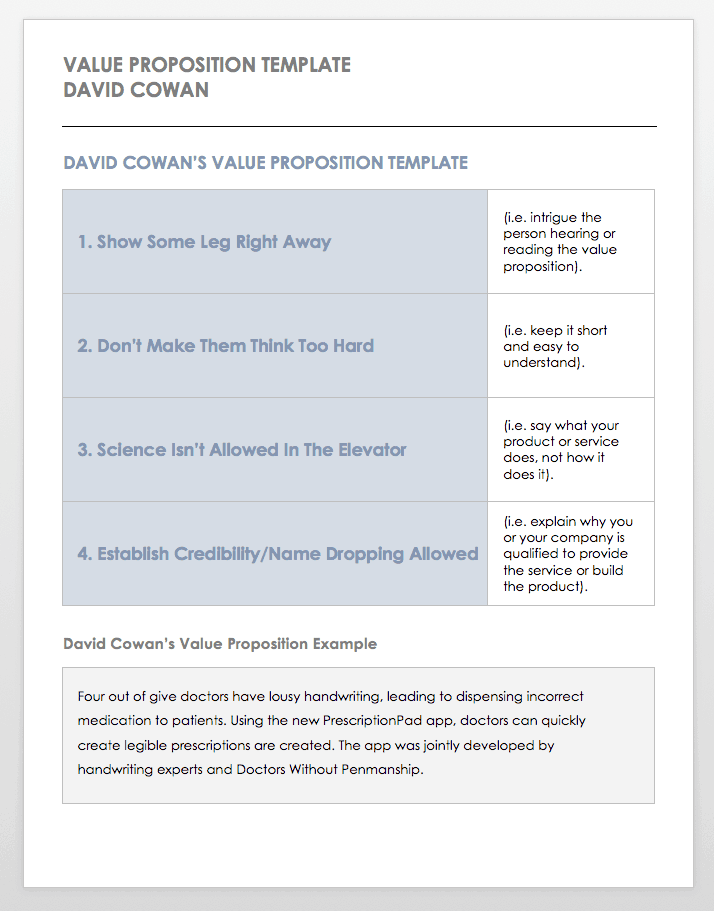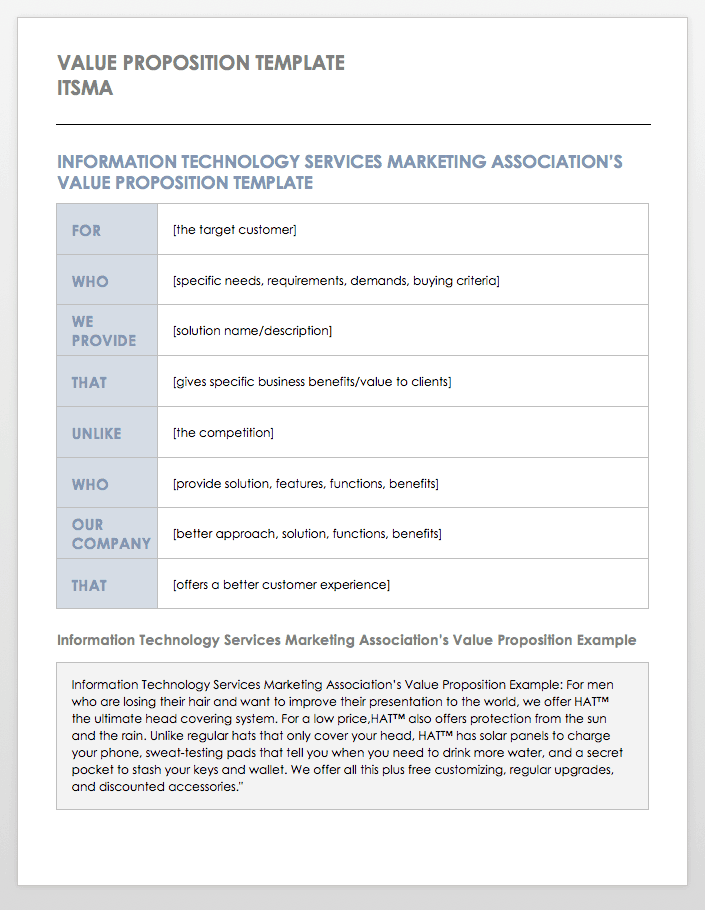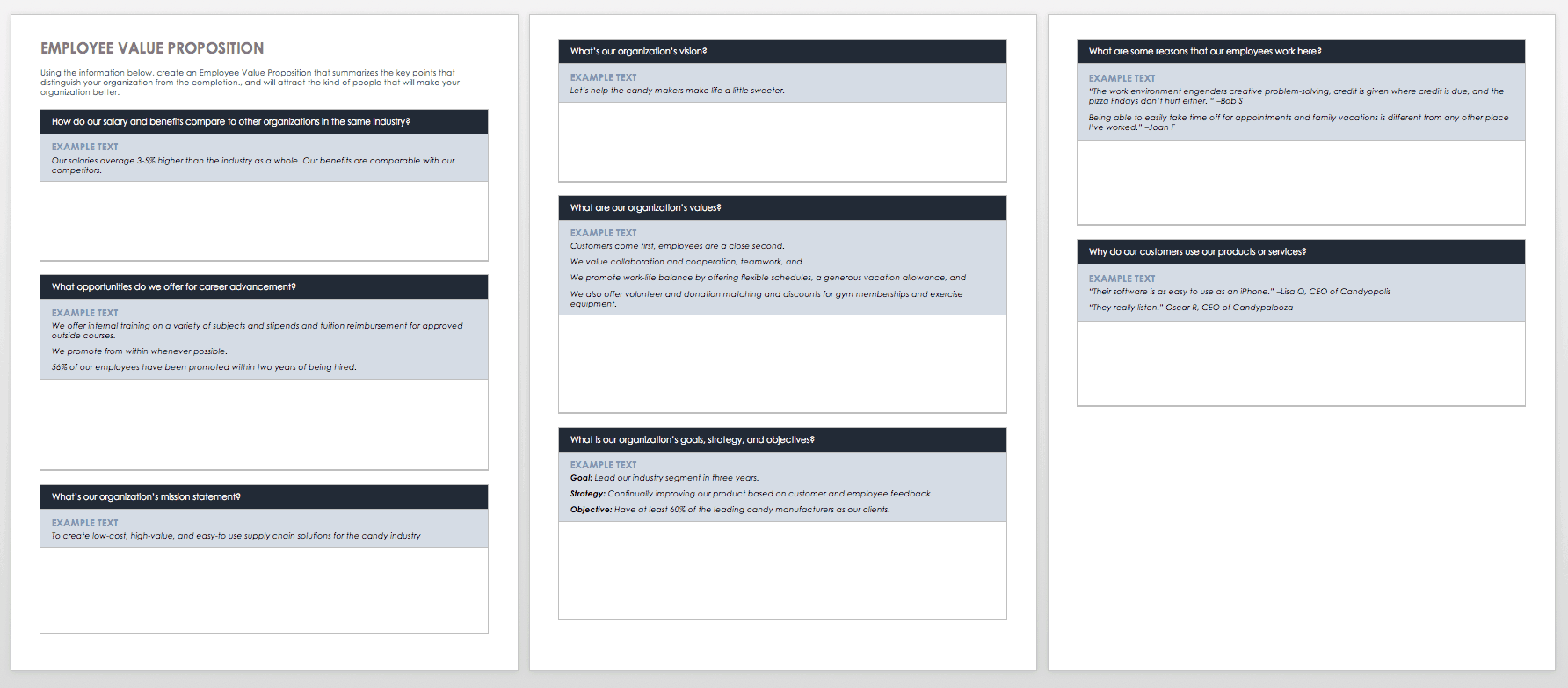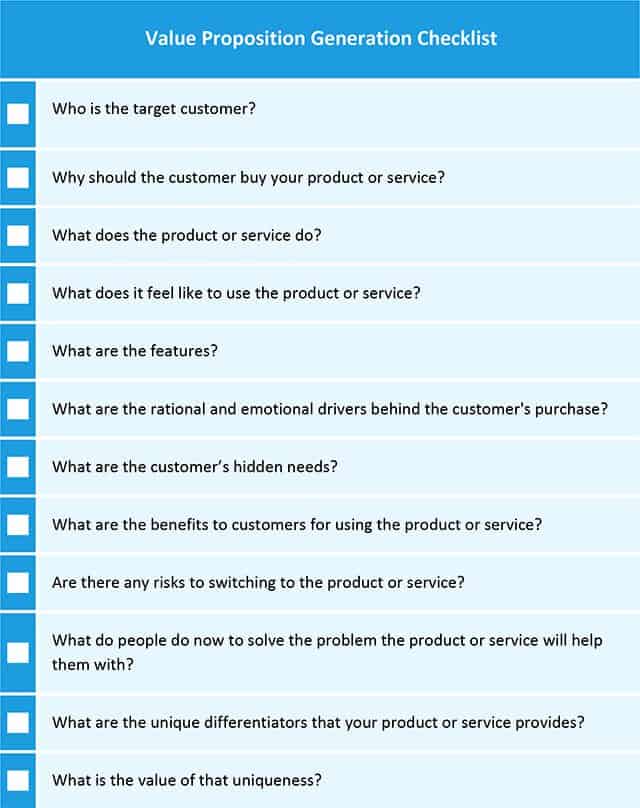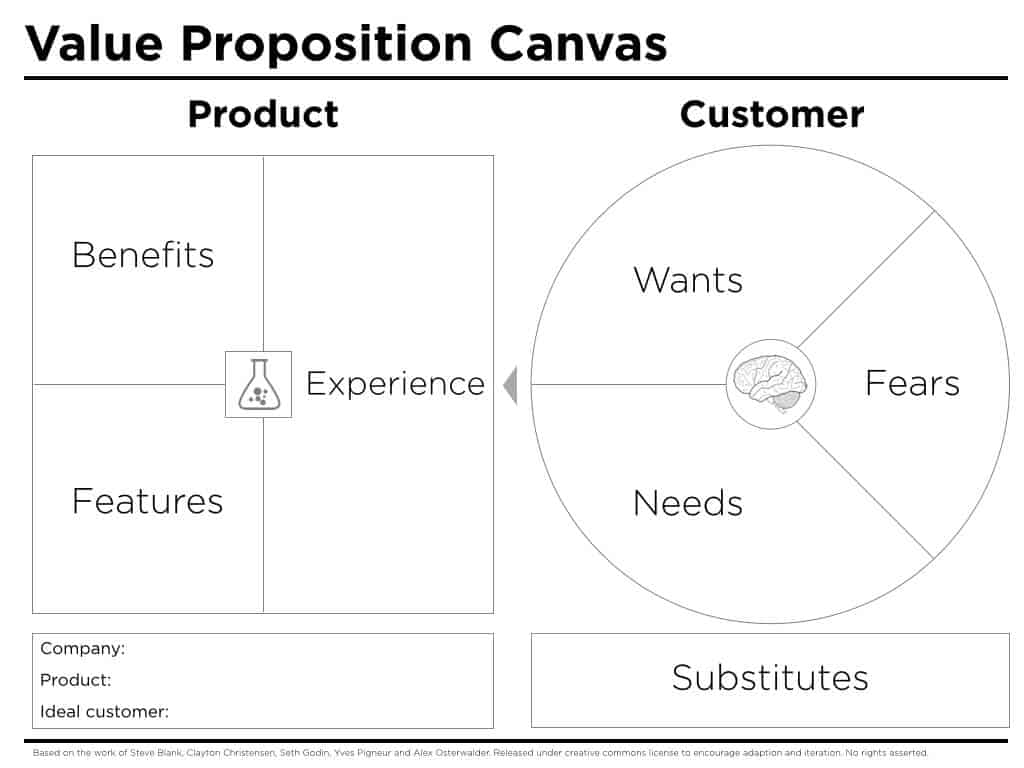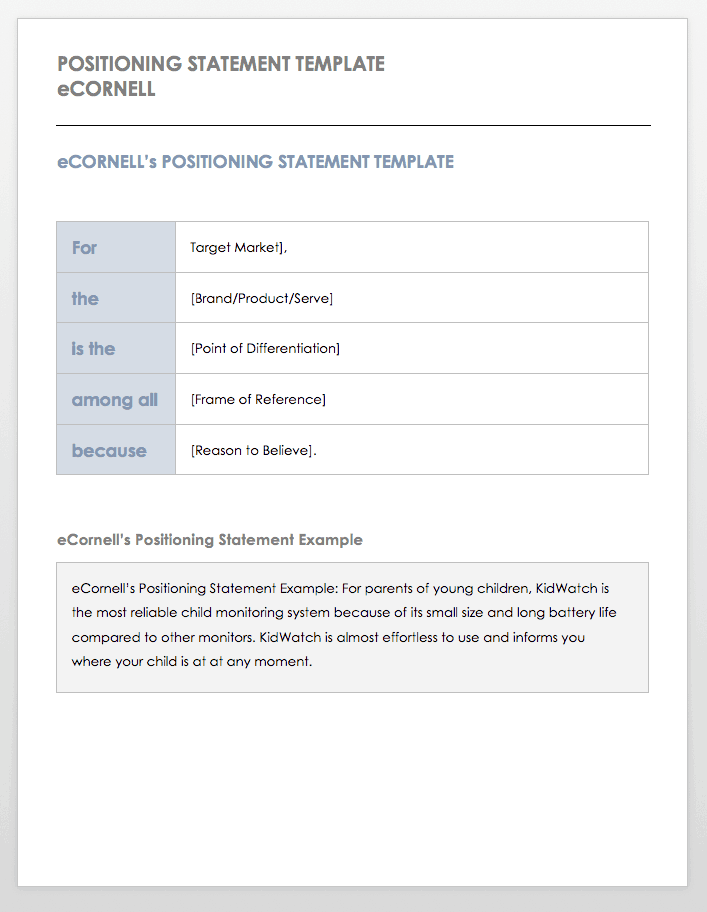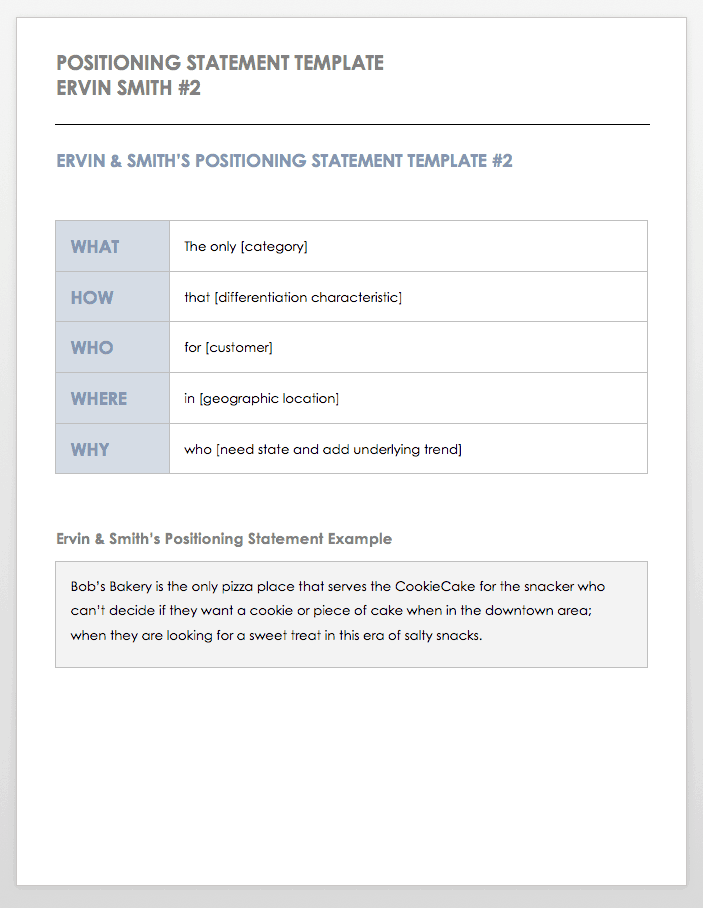Free Value Proposition Templates
There are a number of ideas on the best format for value propositions. We’ve collected some of the most useful expert suggestions and created free downloadable templates that you can use to master your own value proposition.
Geoff Moore’s Value Proposition Template
Geoff Moore is a management consultant and organizational theorist as well as an author. His value proposition template focuses on creating a statement by filling the following blanks:
For [your target customer]
who [statement of need or opportunity]
our [product/service name]
is [product category]
that [statement of benefit]
Example: For chicken farmers who lose a lot of their flock to predators, SuperCoop’s rugged and connected coop is a simple and effective way to keep the foxes out of the henhouse.
Download Geoff Moore’s Value Proposition Template - Word
Venture Hacks’ Value Proposition Template
Venture Hacks consists of two entrepreneurs and investors (Babak Nivi and Naval Ravikant) who advise startups. Their advice for creating a high-concept pitch is to tout the product or service being promoted as the quintessential example from an existing market for a new area of business. Use the template to create your own catchy value prop.
Example: ADT for chicken coops or Airbnb of cars.
Download Venture Hacks’ Value Proposition Template - Word
Steve Blank’s Value Proposition Template
Entrepreneur and author Steve Blank was instrumental in the the Lean startup movement. He developed a value prop that focuses on customer development for small businesses. His template format is: We help X do Y doing Z.
Example: We help visually impaired pedestrians safely cross the street by providing them with an intuitive audio signaling device.
Download Steve Blank’s Value Proposition Template - Word
Cooper & Vlaskovits’ Proposition Template
Patrick Vlaskovits and Brant Cooper, co-authors of The Entrepreneur’s Guide to Customer Development, created the following template to help startups position themselves:
- Customer: Who your customer is
- Problem: The problem you’re solving for the customer
- Solution: Your solution for the customer's problem
Example: Chicken farmers who are losing hens. The farmers need to keep their flocks safe to predators. Our connected coop lets you monitor what’s prowling outside.
Download Cooper & Vlaskovits’ Proposition Template - Word
Dave McClure’s Value Proposition Template
Dave McClure, investor and entrepreneur, developed a template based on the classic elevator pitch. The following are the rules for crafting this messaging:
- Be short, simple, memorable; what, how, why.
- Contain a maximum of three keywords or phrases and two sentences.
- Contain no jargon.
Example: Our customization app is the quickest and easiest way for you to create personalized t-shirts that are shipped to you in two days or less.
Download Dave McClure’s Value Proposition Template - Word
David Cowan’s Value Proposition Template
Venture capitalist and entrepreneur David Cowan wrote a post called “Practicing the Art of Pitchcraft” in which he outlines his tips for creating a value prop. His template is structured like this:
- Show Something Interesting Right Away: Intrigue the person hearing or reading the VP.
- Don’t Make Them Think Too Hard: Keep it short and easy to understand.
- Science Not Allowed In The Elevator: Say what your product or service does, not how it does it.
- Establish Credibility. Name Dropping Allowed: Explain why you or your company is qualified to provide the service or build the product.
Example: Four out of five doctors have lousy handwriting, leading to patients taking incorrect medication. Using the new PrescriptionPad app, doctors can are create legible prescriptions in a flash. Jointly developed by handwriting experts and Doctors Without Penmanship.
Download David Cowan’s Value Proposition Template - Word
Erik Sink’s Value Proposition Template
Software developer and entrepreneur Eric Sink developed a basic value proposition template that includes the following:
- Superlative: Why this product
- Label: What is this product
- Qualifiers: Who should choose this product
Example: The most effective flock protection system for tech-savvy chicken farmers.
Download Erik Sink’s Value Proposition Template - Word
Guy Kawasaki’s Value Proposition Template
Guy Kawasaki, tech evangelist, author, and one of Apple’s best-known alumni, proposed the verb, application, differentiator (VAD) format. Use this template to write a compact, precise value proposition.
Example: Lose weight with our cloud-based diet app.
Download Guy Kawasaki’s Value Proposition Template - Word
Information Technology Services Marketing Association’s Value Proposition Template
The ITSMA (Information Technology Services Marketing Association) is a professional organization that recommends the following value proposition guidelines:
- For [the target customer]
- Who [specific needs, requirements, demands, buying criteria]
- We provide [solution name/description]
- That [gives specific business benefits/value to clients]
- Unlike [the competition]
- Who [provide solution, features, functions, benefits]
- Our company [more/better approach, solution, functions, benefits]
- That [offers a better customer experience]
Example: For the discerning chicken farmer who needs better flock protection, SuperCoop provides a rugged and connected coop system that keeps predators at bay. Unlike CoopCo, who sells a coop kit with no guarantee, we provide web-based monitoring, stronger materials, a five-year warranty, and 24-hour customer service to protect your flock and create peace of mind.
Download ITSMA’s Value Proposition Template - Word
Employee Value Proposition Template
An employee value proposition (EVP) lays out the benefits a company offers in return for the skills and labor their employees provide. An EVP should include information about salary, benefits, career development, structure, interpersonal factors, mission statement, vision, values, strategy, goals, and objectives. The value prop can also list reasons that people work for the organization and why customers use their products or services.
In the same way a traditional value prop helps a company communicate their brand to potential customers, an employee value prop enables them to portray their brand to potential employees. Similar to how a value prop differentiates a product or service as a tool for solving a problem, an EVP should differentiate the organization as a place to work. The benefits of an EVP for the organization include an increase of team members recommending it as a good place to work, a reduction in turnover by attracting employees that will be a better fit, and greater commitment from new hires.
Creating an EVP is a long process — one that may expose some aspects that the organization will have to work on changing in order to attract and retain the employees they want. That type of process is beyond the scope of this article, but creating a first draft of an EVP with the attached free template may help organizations begin to identify opportunities for improvement.
Download Template in Word
Try Smartsheet Template
Expert Advice for Creating Value Propositions
What Is a Value Proposition?
A value proposition (also called a customer value proposition or value prop) is a high-concept, carefully-crafted pitch that explains the benefits of using your product or service and what problems it solves to your ideal customer. The statement outlines the advantages of the product or service to a customer and what makes your company or solution unique and superior to alternatives.
Often, the value proposition is a single sentence. It’s neither a tagline nor a positioning statement, though it’s related to both.
When creating a value proposition, experts say it needs to explain how the product or service is unique. This can be the toughest part of the process.
Michael Skok, an entrepreneur and business consultant states, “In its simplest terms, a value proposition is a positioning statement that explains what benefit you provide for who and how you do it uniquely well. It describes your target buyer, the pain point you solve, and why you’re distinctly better than the alternatives.”
A value proposition is designed to be used externally, by sales and marketing teams, to attempt to sell the product or service to potential customers. A value prop may determine if a potential customer responds to a sales pitch or not, or stays on a website to read more or decides to leave the page and continue looking at the search engine’s results. Companies can also use value prop to request funding.
Get Started Creating a Value Proposition
In order to make sure you’re ready to to start working on a positioning statement, ask yourself these questions:
Download Value Proposition Generation Checklist
Once the value proposition is complete, test it by putting it front of some people to get their reactions.
Value Proposition Frameworks
The following frameworks can also be used to help create a value proposition, and can incorporate any of the templates above.
Mindtools is a management and leadership training site. They recommend the following framework:
- Identify your goal.
- Explain what you do.
- Communicate your unique selling proposition (USP).
- Engage with a question.
- Put it together.
- Practice.
Marketing consultant Peter Sandeen’s method for creating a value proposition starts with hitting people over the head with what makes your product or service different. To do so, answer the following questions:
- What makes you valuable? Collect all of the most persuasive reasons people should notice you and take the action you're requesting.
- Can you prove that? Use studies, testimonials, social proof, etc. to prove your claim.
Peep Laja, entrepreneur and writer, created a template that consists of a short paragraph and a photo. Here is the framework for the paragraph:
- Headline: What is the end-benefit you’re offering? Write it in one short sentence. You can mention the product and/or the customer. Include an attention grabber.
- Sub-headline or a two to three sentence paragraph: A specific explanation of what you do or offer, for whom, and why it is useful.
- Three bullet points: List the key benefits or features.
- Visual: Images communicate much faster than words. Show the product, the hero shot or an image reinforcing your main message.
Brand strategist Peter Thomson suggests using a value proposition canvas (similar to a business plan canvas), which is a diagram that includes sections for information about the product (experience, features, and benefits) the customer (wants, needs, and fears), as well as a section to list substitutes for the product.
You can use a value proposition canvas as a framework for brainstorming. One way to use this framework is to post a large version of the chart on a wall and add items with Post-it notes.
Once you’ve added the items, use the information you’ve gathered to create a value prop.
Tips for Creating a Value Proposition
There’s always someone selling similar products, so a strong value prop will help differentiate you from the crowd. When creating a value proposition, there are a lot of things to keep in mind to make it stand out. Here are some major ones:
- Keep it short and simple.
- Know your audience.
- Be clear.
- It's not a tagline or a positioning statement, but the positioning statement is a good starting point.
- Be aware of hype, jargon, and superlatives. A little goes a long way.
- It should be considered a conversation starter, not the final word.
- It should help explain why your product or service is unique, and why your company is special.
- Focus on benefits over features
- Be specific.
- The less your company is known, the better your value proposition needs to be.
- Focus on the value to the customer.
- Be relevant to customer needs.
- Tell a story.
Real-World Examples of Effective Value Propositions
There are many value propositions in the world. Once you know how to identify them, you’ll recognize them just about everywhere you look. In fact, some companies will often have more than one value prop to attempt to reach different customer segments. A few are below:
- Uber: Tap the app, get a ride.
- Slack: All your tools in one place.
- Spotify: Music for everyone.
- Listia: Sell your old stuff. Get new stuff for free.
- DuckDuckGo: The search engine that doesn’t track you.
- QuickBooks: Send invoices in minutes and get paid two days faster.
What Is a Positioning Statement?
A positioning statement, (also known as a market positioning statement, positioning strategy document, brand strategy, or brand positioning statement) is designed to be used internally by the marketing team to craft the way a product, service, or brand is presented to potential customers. Sometimes considered a reference document for other branding activities, a positioning statement can help set the direction for a brand, product, or service by identifying the target market and helping to guide its marketing activities (including pricing, packaging, promotions, and distribution).
Al Ries and Jack Trout, who applied term positioning to marketing and also wrote a book about it (Positioning: The Battle for Your Mind), explain that a positioning statement is “...an organized system for finding a window in the mind. It is based on the concept that communication can only take place at the right time and under the right circumstances.”
The positioning statement generally includes the target audience of the product or service, competitors (both primary and secondary), the benefit to the customer if they choose to buy from you, and the reasons to believe. Once created, this statement may be one of the inputs used to create the value proposition.
Cairns of ProStrategix Consulting says, “The positioning statement puts the value proposition into context. So for the positioning statement there's a formula that helps you define and think through all the different steps that are important in positioning.”
What Is a Reason to Believe?
The marketing term reason to believe (RTB) is a rationale for a customer to buy a product or use a service. An RTB can be logical (“Scientifically proven to brighten teeth”), emotional (“Your smile will be brighter than it’s ever been”), an endorsement (“Recommended by 98% of dentists”), or explanatory (“Uses both carbamide peroxide and hydrogen peroxide to whiten your teeth”). These reasons should be verifiable and define the unique benefits of the product or service you’re selling. Reason to believe statements help you decide how to convince potential customers why your product or service will be best for them.
Free Positioning Statement Templates
There are many ideas on the best way to create a positioning statement. You’ll find suggestions from experts and free downloadable templates below — use these options to create brand positioning statements, product positioning statements, or service positioning statements
eCornell’s Positioning Statement Template
Affiliated with Cornell University, eCornell provides a straightforward approach:
For [Target Market], the [Brand] is the [Point of Differentiation] among all [Frame of Reference] because [Reason to Believe].
Example: For parents of young children, KidWatch is the most effective child monitoring system due to its small size and long battery life compared to other monitors, making it almost effortless to use, and informs you where your child is at at any moment.
Download eCornell’s Positioning Statement Template - Word
Ervin & Smith’s Positioning Statement Templates
Ervin&Smith is a marketing and brand consultant that offers a couple of options to help create a positioning statement. The first is simple:
[Name of Business] is [Kind of Product or Service] for [Kind of People]
Example: ExecCalendar is the modern scheduling system for busy executives.
Download the Short Ervin & Smith’s Positioning Statement - Word
The second option will help you flush out your positioning, which can be useful to include in longer marketing and business materials. Here’s the outline:
- What: The only [category]
- How: That [differentiation characteristic]
- Who: For [customer]
- Where: In [geographic location]
- Why: Who [need state]
- When: During [underlying trend]
Example: SuperCoop is the only farm equipment manufacturer that makes rugged, web-enabled chicken protection systems for farmers in areas infested with foxes, coyotes, and raccoons who want to protect their flocks from increasingly-bold predators.
Download the Longer Ervin & Smith’s Positioning Statement - Word
How to Create a Positioning Statement
There are two types of positioning statements: B2B (business to business) and B2C (business to consumer). Since businesses and consumers have very different needs, what works for one won’t work for the other. Positioning is not a discrete action; rather, it’s the result of your customer’s perception of what you do. It’s imperative to avoid developing the statement in a vacuum. Instead, listen to your customers (or potential customers) and watch how they interact with your product or service. Use what you learn to create a positioning statement that the sales and marketing teams can use effectively.
A positioning statement is not a tagline, but it can be related to it. A tagline is generally shorter catchy, and doesn’t focus too much on benefits or reasons to believe. Think: Nike’s “Just Do It” or M&Ms “Melts in Your Mouth, Not in Your Hand.”
ProStrategix Consulting’s Cairns emphasizes, “There are two things that are important: the word ‘only,’ and how you define your category because you're setting yourself up within the context of the other choices that your target has to solve his or her problem. So, the positioning statement basically starts off with the person or persons that actually need your services, or who needs you. You clarify that need with such language that suggests only your brand can deliver the benefits. Then, you give a couple of reasons to believe. So the typical format is for [Target] who has [Expressed desire or need that you that only you can deliver], [Brand X] is the only brand in the category in which you compete that provides [the value proposition or benefit because], and one or two support points to prove why your benefit is true.”
Tips for Creating a Positioning Statement
When creating a positioning statement, there are a lot of things to keep in mind to make it effective. Follow these two essential tips to get started:
- Create a benefit ladder: Also called a brand ladder, a benefit ladder is a list of levels of benefits of a product or service available to the customer throughout the its lifecycle. The levels include attributes of the product (our phone has a 5.5-inch screen) as well as functional benefits (20 percent longer battery life) and emotional benefits (stay connected with your family).
- Create a positioning diagram: A positioning diagram, which was discussed in Philip Kotler’s classic textbook Marketing Management, compares qualities to help decide how to position the product or service. Come up with two attributes of the product or service that can vary (large to small, fast to slow, etc.). Place them on crossed axes, and insert your product and competitive products on the grid to see how they fare. It’s comparable to a decision matrix.
Questions to Ask Before Creating a Positioning Statement
In order to ensure you’re ready to to start working on a positioning statement, ask yourself these questions:
- How should the brand be positioned against the competitors?
- Who is the competition?
- Who is the target customer or industry?
- What are you trying to communicate?
- What are our taglines?
- Why was this business started?
- How is the product or service designed and created?
- What is the product or service’s uniqueness?
- How is the brand currently being positioned?
- How are competitors positioning their brands?
CXL Institute research showed that users did the following:
- Noticed the value proposition sooner when it had more text, and took up more space on the page.
- Spent longer looking at a value proposition when there was more to read.
- Recalled more services when more services were listed.
- Could describe more features and benefits available when more were listed.
- Preferred bulleted lists.
- Page design preference was influenced by which variation was originally seen.
Use this checklist to verify that your positioning statement covers everything that it should and that it’s formatted in a way that it’s easy to understand.
- It differentiates your brand.
- It matches customer perceptions of your brand.
- It allows for growth.
- It identifies your brand’s unique value to your customers.
- It produces a picture in the customer’s minds that’s different from competitors.
- It is focused on your core customers.
- It is memorable and motivating.
- It is consistent with other areas of your business.
- It is clear.
- It is difficult to replicate.
- It leaves room for growth.
- The benefits listed are believable and credible.
- It will help you make more effective marketing and branding decisions.
Once the positioning statement is complete, test it by putting it front of some people to get their reactions. This document can now be used as the basis for all marketing efforts, so everyone in the organization should agree on the statement.
Real-World Examples of Effective Positioning Statements
Since positioning statements are internally-focused, they don’t often slip out into the wider world. However, below are a few that can give you a sense of what you’re trying to create for your own company.
- Volvo: For upscale American families, Volvo is the family automobile that offers maximum safety.
- Home Depot: The hardware department store for do-it-yourselfers.
- Trader Joe’s: Trader Joe’s flies the world in search of new and unique items for your enjoyment.
Deliver on Your Company’s Value Proposition with Real-Time Work Management in Smartsheet
The best marketing teams know the importance of effective campaign management, consistent creative operations, and powerful event logistics -- and Smartsheet helps you deliver on all three so you can be more effective and achieve more.
The Smartsheet platform makes it easy to plan, capture, manage, and report on work from anywhere, helping your team be more effective and get more done. Report on key metrics and get real-time visibility into work as it happens with roll-up reports, dashboards, and automated workflows built to keep your team connected and informed.
When teams have clarity into the work getting done, there’s no telling how much more they can accomplish in the same amount of time. Try Smartsheet for free, today.
